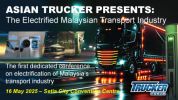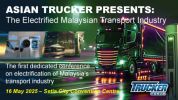“Her outstanding leadership and vast stakeholder management experience covering corporate planning, project management, distribution operations, as well as regional business and strategy development, will be invaluable to SPAD, as the planner and regulator of land public transport for the nation.
We are very pleased that Qamar is joining us at this important stage in our development, as we accelerate the implementation of land public transport projects aimed at improving urban mobility and enhancing urban-rural connectivity as envisioned by the Government,” said Mohd Azharuddin Mat Sah, Chief Executive Officer, Land Public Transport Commission (SPAD).
Qamar will be responsible for the overall transformation of the freight, bus and taxi industry and its related infrastructure, which includes the roll-out of national projects such as the myBAS under the stage bus transformation programme and the bus network revamp in Greater Kuala Lumpur and Klang Valley to ensure an efficient, integrated and sustainable bus system that focuses on improving journey quality for commuters.
“The land public transport sector is a thriving industry, and SPAD is committed to fostering workforce diversity in various levels as we gear forward,” added Azharuddin.
Shell Shared Insights on TOC at MCVE 2017
According to Shell Lubricants Marketing Manager – Malaysia and Singapore, Alex Lim, the company presented key findings from the TCO Fleet Paper developed by Shell Lubricants based on results of an international survey conducted among 395 decision makers in the fleet sector in eight major countries all over the world. Summary findings revealed that many fleet companies underestimate on the importance of effective lubrication in helping to reduce costs and improve equipment productivity. Instead, lubricants are often the first to be considered when cutting costs.
At Shell, TCO is defined as the total amount spent on a vehicle or equipment, including cost of acquisition and operation over its entire working life; as well as the costs of lost productivity during downtime.
More than half of fleet managers and owners who took part in the survey did not consider the correlation between quality lubricants and TCO. Two-thirds of the survey respondents did not consider that using a better oil would help reduce unplanned and costly downtime. Only half of them would consider the lubricant’s performance as an important purchase consideration. This is where and how Shell products come into place and help in lowering the costs, added Alex.
QUESTION AND ANSWER SESSION WITH MR ALEX LIM, SHELL LUBRICANTS MARKETING MANAGER – MALAYSIA AND SINGAPORE
Question (Q): Tell us about the key findings of the survey on the fleet sector.
Alex Lim (AL): Summary findings reveal that many fleet companies underestimate the importance of effective lubrication in helping to reduce costs and improve equipment productivity. Instead, fleet companies often compromise on lubricants in times of optimisation:
• More than half of the respondents admitted that concessions to lubrication had led to costly breakdowns.
• More than half of fleet managers and owners who took part in the survey did not think that higher quality lubricants would help in lowering maintenance costs.
• Nearly two-thirds of them did not think that using a better oil would help reduce unplanned and costly downtime.
• Only half of them would consider the lubricant’s performance as an important purchase consideration.
• One in three believed that unplanned downtime has cost them more than RM435,0001 while one in five said that they have lost more than RM1 million1 over the last three years. That is a lot of money, especially in challenging times.
Q: What are the reasons for this?
AL: The correlation between vehicle lubrication and vehicle downtime, maintenance costs and fuel costs is greatly underestimated because the benefits of using higher quality lubricants are often overlooked and misunderstood. Higher quality lubricants comparably cost more upfront, but in the long run, usage of high quality lubricants will help reduce breakdowns and downtimes which in turn, lowers the total cost of ownership.
Q: How can a lubricant manufacturer like Shell help overcome this lack of understanding?
AL: At the MCVE 2017, we shared findings of the Shell Lubricants TCO Fleet Paper with our customers to help them better understand the important role that lubricants play in helping to lower the total cost of ownership (TCO). At Shell, we define TCO as the total amount spent on a vehicle or equipment, including cost of acquisition and operation over its entire working life; and also equally important, the costs of lost productivity during downtime. We hope the details of our white paper will enable key decision makers in the fleet sector decide what is best for their business longevity.
Q: What should a fleet owner or operator do?
AL: With fuel costs amounting to as much as 39% of total fleet operating costs, a lubricant that helps deliver even a small increase in fuel efficiency has the potential to greatly impact total cost of ownership.
It is all about making smart decisions. First, always choose the right lubricant or grease. Second, implement effective lubrication management2 as even the best lubricants cannot perform if they are not managed properly. Always ensure that employees are properly trained to handle lubricants, manage the right place and amount for optimum storage, and carefully deploy lubricants for use.
Q: What can Shell offer to those who are keen to lower their TCOs?
AL: At Shell, we can help businesses improve vehicle reliability and lower maintenance costs through effective lubrication, thereby, lowering costs per kilometre. From 2011 till 2015, we have delivered RM605 million3 in savings to customers worldwide by offering a complete range of the most advanced lubricants and greases for the entire driveline.
We have a 260-strong team of Shell Technical Experts to assist customers in identifying lubricant-related issues and resolve them. We also have a full portfolio of value-added services to help in lubrication management.








